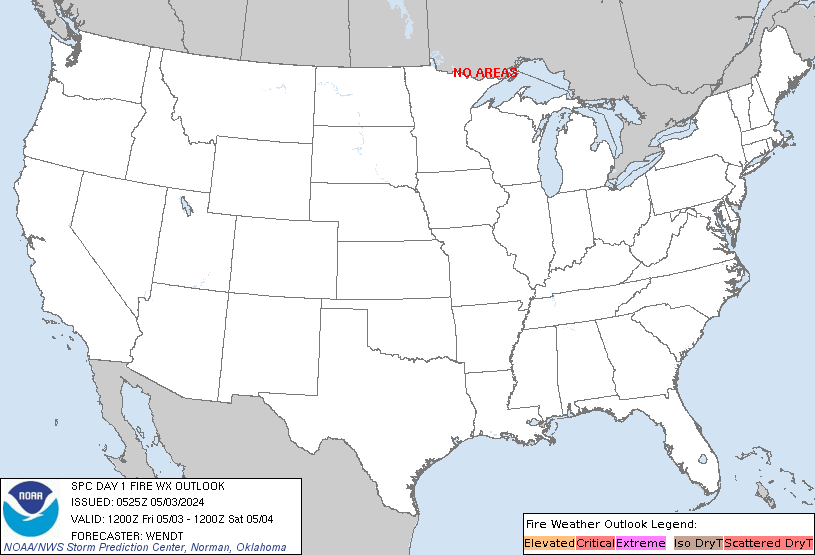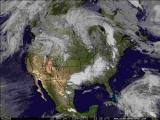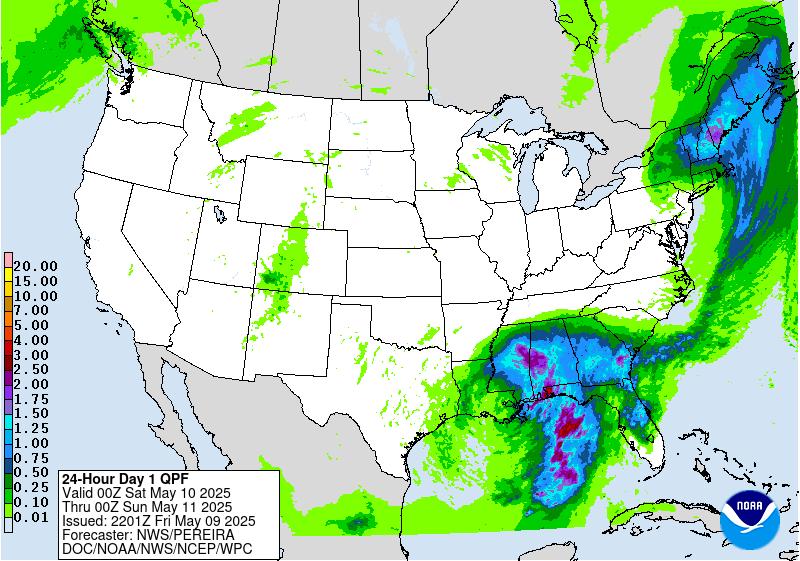No watches are valid as of Tue Apr 30 16:34:01 UTC 2024.No Mesoscale Discussions are in effect as of Tue Apr 30 16:34:01 UTC 2024.SPC 1300Z Day 1 Outlook

Day 1 Convective Outlook
NWS Storm Prediction Center Norman OK
0748 AM CDT Tue Apr 30 2024
Valid 301300Z - 011200Z
...THERE IS AN ENHANCED RISK OF SEVERE THUNDERSTORMS FROM CENTRAL
AND WESTERN IOWA TO NORTHEASTERN KANSAS...
...SUMMARY...
The greatest threat for severe weather (large hail severe gusts and
a few tornadoes possible) is from western and central Iowa to
northeastern Kansas.
...Synopsis...
A fairly low-amplitude, nearly zonal pattern will remain across the
CONUS east of the Rockies, and downstream from a slow-moving mid/
upper-level cyclone now over the northern Rockies. By the end of
the period, this cyclone (containing numerous mesoscale vorticity
lobes/shortwaves) should pivot to the northern High Plains, roughly
astride the northern border of MT and ND with the Canadian Prairie
Provinces.
The most impactful associated feature will be a shortwave trough
evident in moisture-channel imagery over portions of eastern MT into
central/southern WY. This perturbation should shift eastward to
near a BIS-MHE-LNK axis by 00Z, then eject northeastward over the
upper Mississippi Valley tonight. Meanwhile, in response to height
falls and synoptic trough amplification over the Intermountain West,
south of the cyclone, flow over the central and southern Rockies and
adjoining Plains should back gradually to southwesterly, but with
few, if any, notable embedded perturbations today.
At the surface, 11Z analysis showed a low over northwestern SD, with
occluded/cold front arching across western SD, western NE and
northern CO. The low should move eastward to northeastern SD by
00Z, with a triple point over northern IA or extreme southern MN,
warm front to northern IL, and cold front to northeastern and
south-central KS, the OK Panhandle, and Raton Mesa. That low should
move over southern MN and northern WI through tonight, possibly
reaching western Upper MI by 12Z, while the cold front reaches
northeastern IL, the central/western Ozarks, and northern OK,
stalling near a lee-side/frontal-wave low in the CAO/DHT area by
12Z. As moisture return continues, a dryline will become better
defined today from central KS to the TX Permian Basin, shifting
eastward to east-central KS, north-central/southwestern OK,
northwest TX, and northernmost Coahuila before stalling late this
afternoon.
...Lower Missouri Valley and vicinity...
Widely scattered to scattered thunderstorms are forecast to form
this afternoon--earliest around the Siouxland area and later with
southward extent. All forms of severe are possible, but with an
earlier lean to the greatest hail vs. greatest wind threats.
Activity should coalesce from mid-late afternoon onward and shift
eastward over the outlook area, weakening this evening into tonight.
Observed thermodynamic profiles and forecast soundings from this
area southward toward the Gulf Coast reasonably show a shallow moist
layer in low levels, easily mixed via diurnal heating. This appears
legitimate, related to trajectories emanating from an extensive
area of outflow observed over the northwestern Gulf and adjoining
parts of east TX, LA and AR to the lower Mississippi Valley. That
outflow came from MCS activity yesterday. Nonetheless, diurnal
heating should help to steepen low/middle-level lapse rates
considerably and eliminate MLCINH -- by early afternoon over
northwestern parts of the outlook area (where moisture will be lower
but deep-layer lift/cooling aloft greater), and mid/late afternoon
roughly south of I-80 (stronger heating/moisture, adequate lift).
Strengthening and veering of winds with height will yield enlarged
hodographs and favorable deep-shear profiles for supercells, albeit
with somewhat high LCL atop a deep mixed subcloud layer. Forecast
soundings reasonably depict MLCAPE ranging from around 500-1000 J/kg
in the SUX/FSD area to over 3000 J/kg down the narrow plume of
favorable instability in eastern KS. Effective-shear magnitudes of
50-65 kt and SRH of 200-400 J/kg are expected. This parameter space
and profile will support severe wind and hail, both in early
supercell stages (when large to locally very large hail also is
expected), and as upscale aggregation of convection occurs with
small-scale cold pools.
...Southern Plains...
Isolated to locally scattered thunderstorms, including a few
supercells, are possible for a few hours this afternoon into early
evening, initiating near the dryline and moving slowly east-
southeastward (right movers) to faster northeastward (left movers).
Large hail and severe gusts will be the main concerns, and a
conditional significant (2+ inch diameter) hail risk may occur with
any sustained supercell in this corridor. However, in the absence
of large-scale support, specific foci along the dryline appear
unclear, with coverage uncertain (and probably low) over most of the
area. This makes predictability low for any specific mesobeta-scale
patch where greater unconditional probabilities may develop.
Strong surface heating along the dryline will support at least
isolated thunderstorm development mid/late this afternoon, in an
environment of modest low/middle-level flow but strong veering with
height. Before dark, SRH will be small in the lowest couple km,
however, with effective shear magnitudes in the 30-40-kt range,
supporting a blend of organized multicell and transient/isolated
supercell potential. Steep lapse rates, dewpoints commonly in the
60s F, and enough heating for a deep/well-mixed subcloud layer,
should support MLCAPE of 2000-3500 J/kg. Activity should weaken
considerably after dark.
...NY...
Widely scattered thunderstorms are possible today in a zone of
large-scale ascent preceding the trough aloft, superimposed on
modest low-level convergence related to low-level trough drifting
eastward over the area. The trough may manifest at the surface as a
weak low, but projected inflow-layer parcels should remain largely
(if not entirely) elevated above the boundary layer, where moisture
will be greatest and MUCINH weakest. Elevated MUCAPE of 500-1200
J/kg is possible, and briefly surface-based parcels may be
attainable in pockets of sustained heating over portions of the
Finger Lakes to Catskills vicinities. The best-organized cells may
produce small hail and subsevere gusts. Lack of greater near-
surface instability (magnitude and area), and weak midlevel lapse
rates, preclude a severe threat warranting an unconditional outlook
at this time.
..Edwards/Leitman.. 04/30/2024
SPC 1630Z Day 1 Outlook

Day 1 Convective Outlook
NWS Storm Prediction Center Norman OK
1129 AM CDT Tue Apr 30 2024
Valid 301630Z - 011200Z
...THERE IS AN ENHANCED RISK OF SEVERE THUNDERSTORMS THIS AFTERNOON
AND EVENING ACROSS PARTS OF WESTERN IOWA...SOUTHEAST
NEBRASKA...NORTHEAST KANSAS...AND NORTHWEST MISSOURI...
...SUMMARY...
The greatest threat for severe weather (large hail, severe gusts,
and a few tornadoes) is from western and central Iowa to
northeastern Kansas.
...Eastern NE/Western IA/Northwest MO/Northeast KS...
Water vapor loops show a fast-moving shortwave trough and associated
mid/upper level speed max moving across the central Rockies into the
Plains. Ahead of this trough, southerly low-level winds are
transporting moisture northward with dewpoints in the 60s now as far
north as southeast NE. Continued daytime heating and moisture
advection will lead to a narrow corridor of moderate CAPE over
eastern NE by mid-afternoon. A consensus of morning model guidance
indicated that thunderstorms will form in this regime, with other
intense storms developing southward along the surface cold front
into northeast KS by late afternoon. Forecast soundings show shear
profiles favorable for supercell structures capable of very large
hail and a few tornadoes. After dark, these storms are expected to
congeal into one or more bowing structures that will track eastward
into central IA/northern MO with a greater risk of damaging wind
gusts along with hail and perhaps tornadoes.
...Eastern KS/Western OK/Northwest TX...
The surface dryline will extend southward from northeast KS into
northwest OK and northwest TX. Isolated intense storms are expected
from roughly Wichita northward, with decreasing confidence from
there southward. Weak large scale forcing, rising mid level
heights, and generally warming temperatures at 700mb suggest any
storms that form along the dryline will be widely scattered.
However, large CAPE values, steep mid level lapse rates, and
sufficient vertical shear will support supercell structures capable
of all severe hazards in any storm that can form/sustain. Will
maintain the ongoing SLGT/MRGL areas at this time, but will
reevaluate at 20z.
...NY/PA...
Strong daytime heating is occurring over areas from central NY into
central PA, where dewpoints are in the upper 50s. Forecast
soundings suggest afternoon MLCAPE values of 500-1000 J/kg, leading
to scattered afternoon thunderstorms. Low-level winds are
relatively weak/veered, but sufficient winds aloft and steep
low-level lapse rates could contribute to a risk of gusty/damaging
wind gusts and hail in the strongest cells this afternoon.
..Hart/Lyons.. 04/30/2024
SPC Day 1 Fire Weather Outlook

Day 1 Fire Weather Outlook
NWS Storm Prediction Center Norman OK
1123 AM CDT Tue Apr 30 2024
Valid 301700Z - 011200Z
Trimmed the northeast portion of the Elevated area based on forecast
frontal position today. Otherwise, the forecast remains on track.
See previous discussion below.
..Bentley.. 04/30/2024
.PREV DISCUSSION... /ISSUED 0110 AM CDT Tue Apr 30 2024/
...Synopsis...
A belt of enhanced mid-level flow will spread across the Northern
Rockies from an upper low across the northwestern US today. A
cold frontal passage will bring rainfall across much of eastern
Montana and Wyoming this morning. Behind the cold front, a dry
continental air mass will overspread this region into the western
Dakotas, with relative humidity dropping as low as 15 percent amid
sustained winds 20-25 mph. Fuels within southern Montana into the
western Dakotas, where less rainfall is forecast, are sufficiently
dry to carry risk of Elevated fire weather concerns.
...Please see www.spc.noaa.gov/fire for graphic product...
|























































































